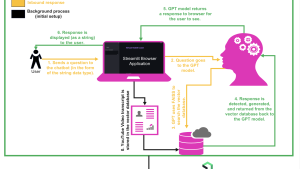AI is transforming industries with the potential to add trillions to the global economy. According to a recent McKinsey report, generative AI has immense potential and is estimated to add $2.6 trillion to $4.4 trillion of value annually to the global economy. CIO/CTOs play a critical role in capturing this value. However, transitioning to AI isn't just a matter of adopting new technologies; it requires a culture and infrastructure that support and optimize its deployment. This blog post delves into the key challenges hindering AI adoption and highlights how observability can be a game-changer for executives seeking to accelerate their AI initiatives.
What is AI observability?
Observability is the ability to measure the internal states of a system by examining its outputs. It’s a critical aspect of modern application and infrastructure management, encompassing metrics, logs, events and traces to provide actionable insights. This holistic view allows organizations to detect, understand, and diagnose issues in real time, ensuring smooth and efficient operations.
AI observability extends this concept to the complex world of AI-powered applications. With deep visibility into AI application performance, data quality, and system behavior, organizations can optimize for accuracy, efficiency, and reliability. Additionally, organizations can mitigate risks such as bias and drift, and address security and compliance concerns. This is essential for ensuring responsible use of AI in production.
The challenges of AI adoption
Before diving into how observability can assist in AI adoption, it's essential to recognize the inherent challenges:
- Complexity of AI deployment: Deploying AI models has been a complex and risky process due to significant computational demands and infrastructure requirements.
- Operational efficiency: Seamless integration of AI into existing systems can be challenging due to operational complexity.
- Scalability and performance: Maintaining optimal AI application performance and ensuring infrastructure can scale effectively to meet AI demands are crucial.
- Cost management: Effectively tracking resource consumption is crucial to managing AI model costs and staying within budgetary constraints.
- Data quality and fairness: Ensuring high-quality, reliable data from AI applications is paramount to ensure they are free of bias, toxicity, and hallucinations.
- Security and compliance: Mitigating security risks and adhering to data privacy regulations are critical concerns.
- Culture and skill set: Fostering an AI-driven culture and equipping teams with the necessary skills are essential for successful adoption.
Observability: A catalyst for AI adoption
Simplifying AI application deployment
Traditionally, deploying AI models has been a complex and risky process. Observability tools streamline this process by allowing teams to pre-validate AI applications in staging, ensuring minimal disruption to production systems. Additionally, automated rollouts with real-time monitoring enable safe and swift deployments. If any issues arise, the observability tools allow for instant rollback, minimizing downtime. Finally, detailed metrics and comparison capabilities within these tools provide valuable insights into the performance of different model versions, guiding data scientists towards the optimal choice for deployment.
Maintain operational efficiency
The seamless integration of AI into existing systems is often a challenge due to operational complexity. Observability helps overcome this hurdle by providing a centralized view of all relevant metrics across your AI stack through user-friendly dashboards. This simplifies performance monitoring and troubleshooting. Furthermore, end-to-end tracing allows you to gain a holistic view of transactions and data flows within AI applications, enabling efficient identification of bottlenecks and workflow optimization. Observability also empowers you to proactively identify potential issues before they escalate, ensuring seamless AI integration and smoother operations.
Scalability and performance
Ensuring infrastructure scalability and maintaining performance are critical for successful AI adoption. Observability tools allow you to continuously assess the performance of your AI application, models, and infrastructure. This data-driven approach empowers you to optimize resource allocation and ensure optimal performance. By dynamically allocating resources based on real-time performance metrics provided by observability solutions, you can achieve cost-efficiency. Additionally, these tools help identify and quickly alleviate resource bottlenecks, to prevent slowdowns and ensure smooth operation of your AI systems.
Cost management
Managing the costs associated with AI applications can be challenging. By providing detailed insights into resource and token consumption for your AI application, you can identify areas for optimization. Observability also enables cost-effective scaling through dynamic resource allocation based on real-time performance metrics. This ensures you have the necessary resources when needed, without incurring unnecessary expenses during low-demand periods. Furthermore, observability tools can help pinpoint potential inefficiencies within your AI workflows, allowing you to streamline operations and eliminate wasteful resource usage. This comprehensive cost management approach empowers you to maximize the return on investment (ROI) of your AI initiatives.
Ensuring data quality and fairness
From Forbes statistics, 75% of consumers are concerned about the misinformation from AI. To ensure AI models deliver accurate and reliable results, it's crucial to address potential issues early on. Observability provides the necessary tools to identify and mitigate risks such as bias, hallucinations, and performance bottlenecks. By continuously monitoring AI applications, you can proactively detect and correct data quality issues that can significantly impact model performance. Additionally, advanced anomaly detection capabilities within observability platforms help pinpoint data inconsistencies that might lead to biased or inaccurate outputs. Furthermore, maintaining a detailed record of data transformations through observability enhances transparency and accountability, essential for addressing concerns around model fairness and explainability.
Enhanced security and compliance
Security and compliance are paramount concerns when adopting AI. Based on an ETR research study, 35% of respondents have security concerns, and 31% have compliance and regulation concerns that are limiting the usage of AI in production. Observability tools address these concerns by providing continuous monitoring capabilities. This allows you to keep a watchful eye on unusual activity that could indicate security threats, enabling you to take immediate action and safeguard your systems. Detailed logging and auditing features within observability solutions ensure ongoing adherence to regulatory requirements. Moreover, observability empowers faster and more effective responses to security incidents by enabling rapid identification and analysis of potential threats.
Cultural and skills transformation
Building a culture of AI readiness within your organization requires transparency and collaboration. Observability tools promote transparency and trust by providing teams with clear insights into system performance and AI model behavior through visualizations and dashboards. Additionally, these tools promote collaboration by providing shared observability platforms, allowing teams from different domains to effectively collaborate on AI initiatives. Finally, real-time data insights from observability solutions empower a culture of continuous learning, driving continuous improvement in your AI systems and processes.
The foundation for AI success
Adopting AI is a multifaceted journey that requires not only technological investment but also strategic foresight. Observability emerges as a crucial enabler in this journey, offering real-time insights that enhance data quality, operational efficiency, scalability, security, and cultural transformation. By integrating observability into the core of AI adoption strategies, organizations can navigate the complexities of AI implementation more effectively, ensuring sustained success and a competitive edge in the AI-driven landscape.
Next steps
New Relic AI monitoring empowers you to harness the power of AI with confidence, ensuring responsible, efficient, and scalable AI deployments. Learn more about New Relic AI monitoring.
The views expressed on this blog are those of the author and do not necessarily reflect the views of New Relic. Any solutions offered by the author are environment-specific and not part of the commercial solutions or support offered by New Relic. Please join us exclusively at the Explorers Hub (discuss.newrelic.com) for questions and support related to this blog post. This blog may contain links to content on third-party sites. By providing such links, New Relic does not adopt, guarantee, approve or endorse the information, views or products available on such sites.



